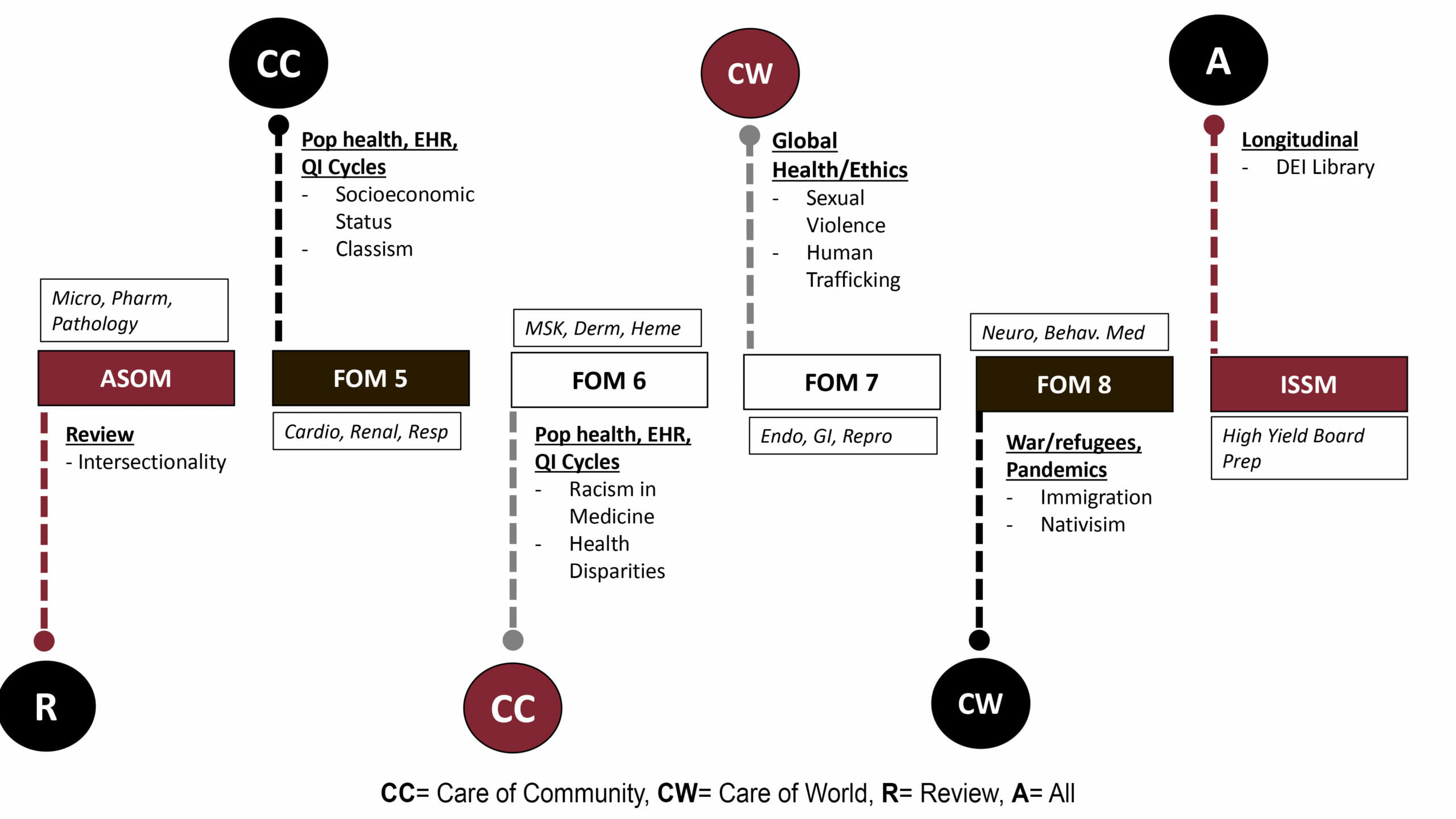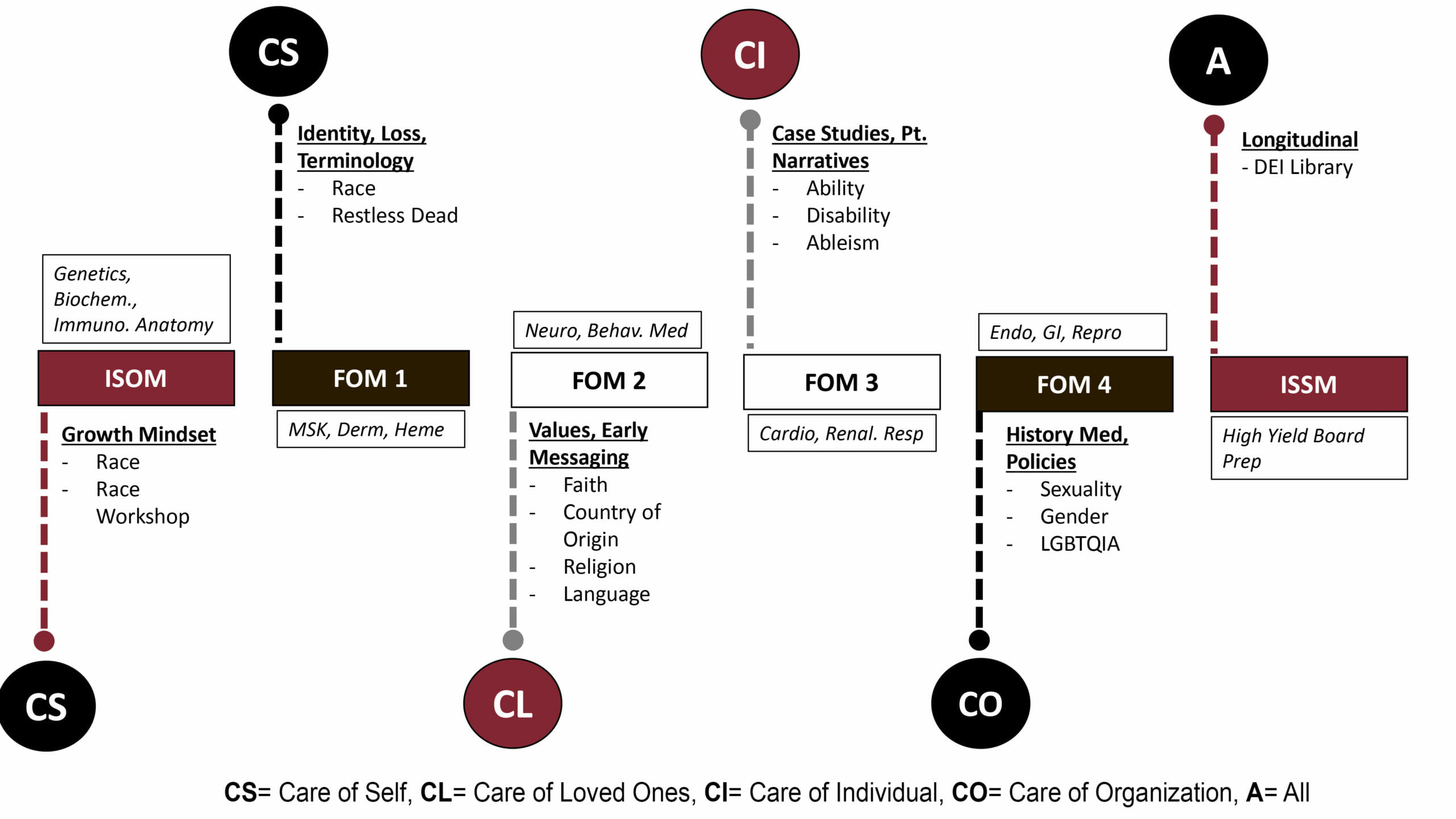
DEI Curriculum
COMP’s longitudinal DEI curriculum features a concentric circles model that urges our students to start with care of self. The curriculum then moves outward to care of loved ones, care of individuals, care of organization, care of communities, then care of world. At each level the students engage in an in-class activity followed by a small group support interaction, that we call Care Teams. Our ultimate goal is to provide the skills necessary to graduate DEI champions that are fluent in providing quality care to all, but importantly the most vulnerable.
DEI Curriculum Learning Objectives:
- Describe the different circles of care and distinguish them based on focus of learning
- Describe the various levels of DEI content mastery from Novice to Intermediate to Advanced
- Describe the inevitable outcome of shaming with regards to DEI training
- Describe to purpose of the Care Team activity
- Describe how shaming results in negative interactions and poor health outcomes
- Describe the role of trust in patient provider relationships
- Describe how patient narratives serve to guide healthcare in the context of DEI
- Articulate and define the terms commonly used in DEI conversations
- Describe how racism and injustice affect health outcomes in vulnerable populations
- Describe health outcome disparities and how to mitigate them at and population-based level
- Describe how advocacy work for individual patients, peers and organizations can result in systemwide change
- Describe principles of community medicine in the global setting
Central Thesis
- Healing comes from within
- Healing is vulnerable, rooted in love and fueled by self-care and self-reflection. One cannot heal without advocacy and personal risk
- When we dive into DEI training and learn first about health disparities data we decouple the patient outcomes from the role of individuals in the moment. Things seem far away or abstract. When we start with statistics, they stay statistics
- When we start with narratives, the statistics become evocative
- Anti-bias work is central to “do no harm,” and requires life-long learning beginning with the self-discovery
Stages of Change
- Think of stages of behavior change, engaging patients in smoking cessation, weight loss, exercise – doctors quoting statistics, scare tactics and didactics have never worked
- These stages require emotional connection with the patient; allowing the patient to identify next steps and being supportive while holding patient accountable works best
- Same is true for anti-bias teaching
- In both scenarios we are asking someone to give up something they value even though it is toxic to them. (cigarettes/white supremacy/privilege)
DEI Content: Four Delivery Methods
Anti-bias teaching in stages throughout the curriculum
Novice
- Learner explores personal identity and history. Recalls and reflects experiences of early life, experiences in health care and past trauma
- Develops understanding of the lens through which he/she/they view the world
- Builds trust with peers and practices sharing authentically
- Listens to new narratives and recognizes value of each story
- Attaches emotional value to individual connections rather than performative allyship
Intermediate
- Learner explores medicine and the role of their profession in upholding or dismantling injustice
- Listens to individual patient narratives in the context of office visits, hospital accounts, research studies and access to care
- Reflects critically on COMP/COMP-NW and WesternU as institutions of higher learning in context of DEI
- Practices advocacy work for individual patients, peers and for organizational change
- Serves in peer education roles and committee service
Advanced
- Learner studies broad trends in care and the longitudinal data on individual narratives
- Keeps empathetic focus when studying data sets > each number is a person, a story
- Builds competency via technology to identify and intervene in health disparities
- Learner creates and executes a QI project
- Learner identifies next area of growth and self directs learning activities to address deficits
- Applies principles of community medicine to global setting
Curriculum Leads

Edward Barnes, MD

Stephanie White, DO

Colleen Talbot, PhD



